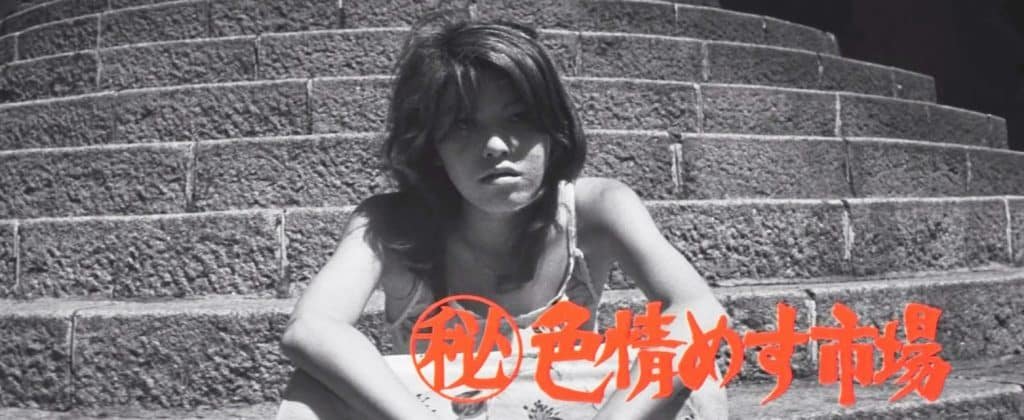
The 1974 Osaka-lensed pink film (Maruhi) Shikijo Mesu Ichiba goes by many English titles. Confidential: Secret Market is certainly the most innocent sounding, Secret Chronicle: Sex Market may give a fair idea about the subject matter, Secret Chronicle: She-Beast Market however comes the closest to the original Japanese and to the actual spirit of the movie. It’s all about destitute life, sex and prostitution in the grittiest part of Osaka, the Kamagasaki homeless area in Nishinari Ward, close to Shin Sekai, the tourist area around Tsutenkaku Tower in neighboring Naniwa Ward.
The film opens with a shot of iconic Tsutenkaku Tower in the distance. The lens zooms out and another structure appears just to the left of Tsutenkaku. A sign on that structure spells out toruko onsen (Turkish hot spring). This is no doubt a variation of the then common term toruko buro (Turkish bath), describing a particular type of prostitution outlet. Those “baths” had in fact nothing to do with Turkey at all. After a campaign by Japanese-resident Turks in the early 1980s, that type was business was re-named soapland – soaplands still dot the red light districts all over Japan.
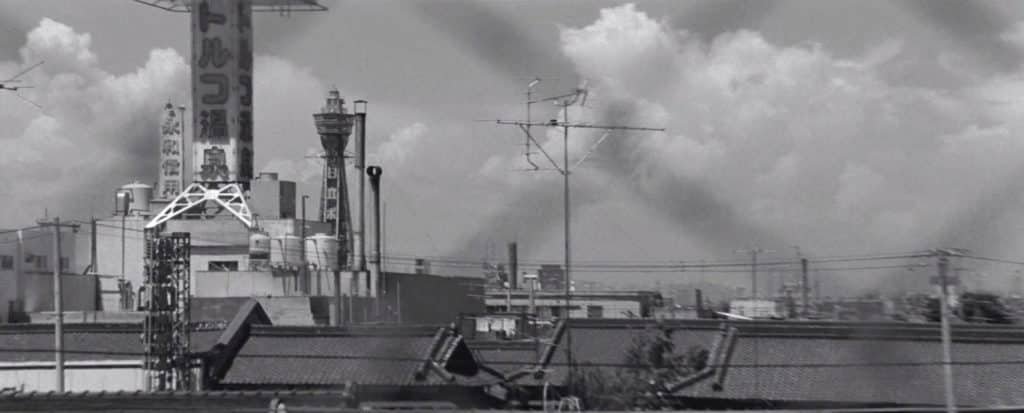
The camera pans to the right, towards two young women leaning against a wall in a dirty side street. They soon proceed to sit down on a stone staircase. One of them is Tome (Meika Seri), a young prostitute working at a brothel nearby, the other is Tome’s mama-san (female pimp). Tome is just declaring her resignation from the brothel and her will to work as an “independent” from now on.
We are never shown the brothel. There is no indication that they refer to the Turkish Onsen. More likely, the brothel in question might be part of Tobita Shinchi, the very traditional and today still legal brothel area, located right inbetween Shin Sekai and Kamagasaki.
The film was all shot on location – but no film crew would ever get permission to shoot in Tobita Shinchi. Even today, all photography is strictly prohibited there.
In any case, Tome, a native of Kamagasaki, then begins to work the streets of the homeless neighborhood. Returning there means to compete with her own mother in the sex trade, it means to live with her retarded sex-crazed brother.
Table of Contents
Secret Chronicle: Sex Market (Japan, 1974) (秘)色情めす市場
Shot in crisp black and white, the film unflinchingly records life in the streets of Kamagasaki and in the many doya (day laborer flophouses) to which Tome is called for her services. Her patrons smoke and drink while in the midst of intercourse, they are creeps with no exception. Sex never looks pretty in this movie, quite the opposite.
Still, Tome runs up and down crowded underpasses, trying to find customers. Those street scenes, many of which appear to throw the actress right into the real Kamagasaki street life, could be straight out of any of the grittiest Italian neo-realist movies of the post-war period. Artfully shot scenes of utter desperation.
Tome meets a mysterious guy she believes she has seen on many police wanted posters. He just says that he also thinks that the photo on the posters looks like him, he doesn’t know why. Tome likes him but then he suddenly disappears. Perhaps caught by police. Perhaps he really was the guy on the poster.
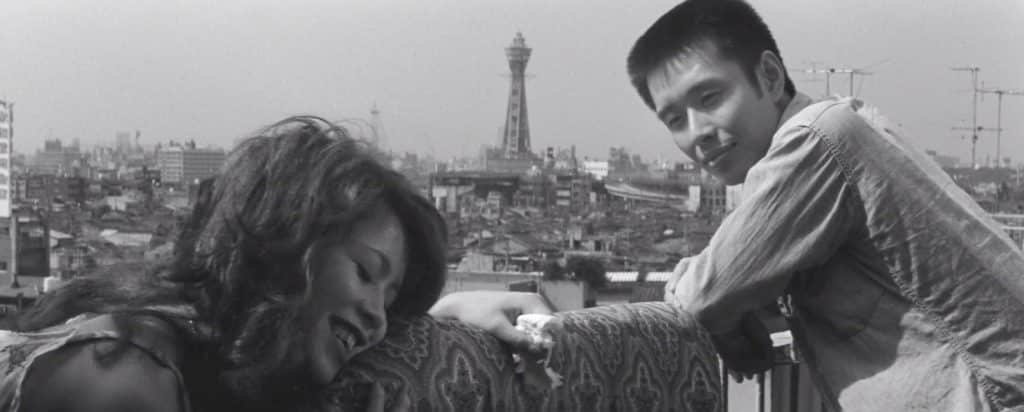
There are hilarious scenes like when Tome is called in to replace her own mother in the hotel bed of a patron. Tome does sexually satisfy her retarded brother. But all in all, Tome’s story is just one of roaming around the neighborhood.
There is a subplot however, that keeps the story going. A hippie couple arrives in town and is picked up by a sex toy shop owner / pimp who claims he has a real pearl imbedded in the skin of his penis, providing for the ultimate satisfaction of all his female partners. In fact, those inserted pearls are indeed an old yakuza tradition.
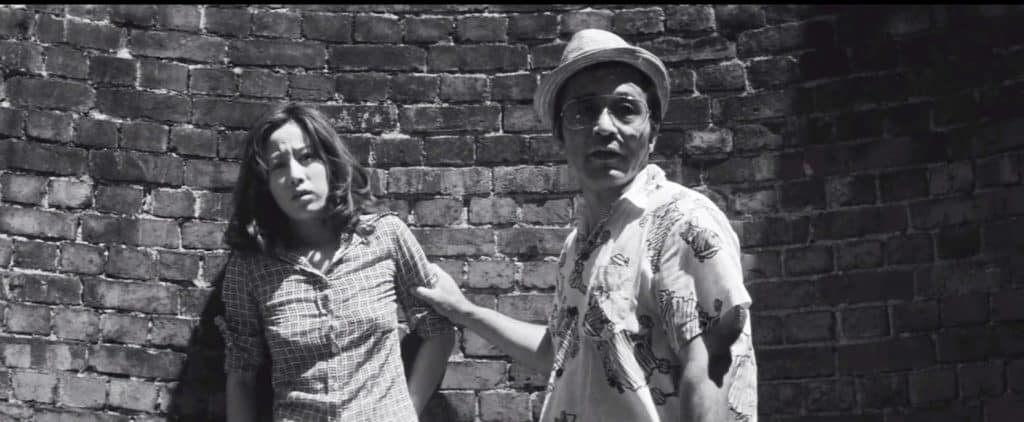
Soon, he takes Fumie, the hippie girl (famous pink actress Junko Miyashita) as his lover, presenting her boyfriend Atsushi (Sakumi Hagiwara) with an inflatable sex doll when telling him to get lost. Some amazing scenes follow until the boyfriend uses the gas-filled sex doll to kill all the three of them in a large explosion.
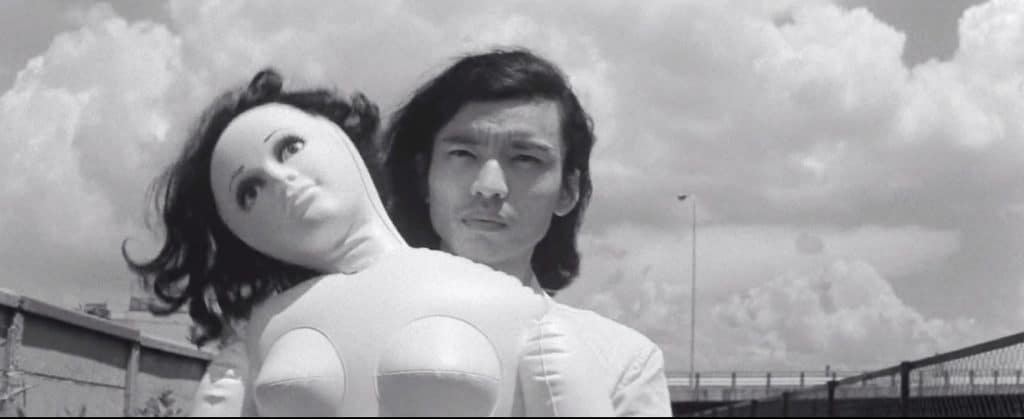
Suddenly, very much towards the end, the movie turns to color. Beautiful bright Fuji Color.
At the time, in the early 1970s, black and white film stock was still much cheaper than color film. Inserting some color sections towards the end was however frequently done in pink movies to spice up the product and to be able to present impressive color images in the display cases outside the movie theaters.
In color, we see Tome’s brother Taneo ascending the steps all the way up to the top of Tsutenkaku Tower, carrying a white rooster in his hands.
Intercut with his ascent are images celebrating the beauty of Osaka. Images of river views, Osaka Castle, Dotonbori, temples and classic gardens. It’s as if, once provided with color film, the camera crew had taken a tourist tour of the city.
Suddenly, Tome meets the mysterious guy again, the man she thought to be a wanted criminal. Again, he tells her that all that poster business was just a mistake. He invites her to take her to a better place.
But by then, Tome has made up her mind. In a defiant speech, she declares: “Everyone in this town is a misfit. No one has any hope. That’s why I am staying. This is where I belong. It’s the perfect place for me.”
She continues her trade in exactly that spirit… leading to quite some strange but hilarious scenes.
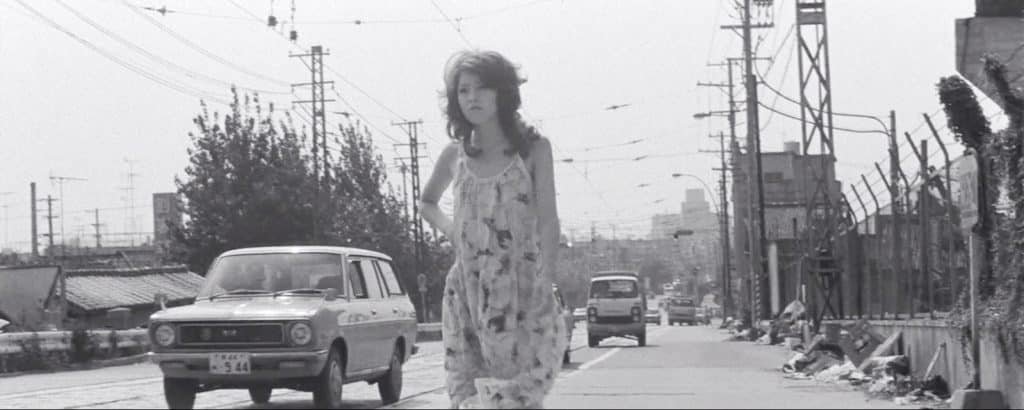
Pink Film / Nikkatsu Roman Porno
Pink film started as a genre in Japanese cinema in the early 1960s. Sensational films initially focused on the life of prostitutes, trying to bring as much sex to the screen as legally permitted.
Blue films aka illegal hardcore pornography were already long available for the ones who knew how to find them. The Pornographers (1966) is a film partially dealing with that particular segment of film history.
In contrast to the blue films, pink film aimed for wide legal audiences. Pink films came with the official approval stamp of the Japanese censorship board, known as Eirin.
That meant that certain restrictions were in place. No matter how steamy the sex scenes were, genitals and pubic hair were absolutely off limits. Nude female breasts were permitted, nude behinds of both genders were fine.
Most importantly, the subject matter and style of the films were absolutely free for grabs. Anything became possible within the genre as long as the “no genitals, no pubic hair” rule was followed.
The time being the 1960s, both new studios specializing in the genre (like Shintoho Eiga) as well as leftist-leaning independent directors / producers like Koji Wakamatsu went all the way they could exploiting headline topics of the day. Namely, the ongoing 1960s youth rebellion with all its violence and propagated sexual freedom… involving lots of good looking student girls.
In 1971, Nikkatsu, Japan’s oldest surviving large film studio (founded in 1912), took a radical turn. Having long been known as a studio reliably churning out films with quite a conservative bend, Nikkatsu suddenly embraced the sexual revolution.
They did so with quite some vigor. Suddenly, at the venerable old studio, young directors got budgets to realize any film they wanted, provided they put in a sex scene every 10 minutes or so into their films.
Budgets were slim but Nikkatsu provided their whole pool of experienced technicians. Classically trained cameramen, lighting technicians, prop makers, sound engineers.
The result was a new genre within the pink film genre: the Nikkatsu Roman Porno.
Nikkatsu owned a large chain of movie theaters throughout Japan and many of those theaters were converted to screen only Nikkatsu Roman Porno.
Those new directors on the Nikkatsu payroll as well as their scenario writers and actors tended to lean towards the counter-cultural tendencies of the day.
They did not promote any immediate violent overthrow of the existing society but they dug into social criticism, they often wanted to bring the life of the unfortunate in society, the life of the disenfranchised to the screen.
All that was fine with Nikkatsu. Grime and sleaze and dirt and violence, bring it on, was their attitude.
Pink films and especially Nikkatsu Roman Porno became opportunities for many new directors to cut their teeth in the movie business.
There was no stigma associated with pink productions. Directors but also actors and actresses who started in the business could easily enter the mainstream film world after initially making their name in the pink genre. In fact a whole generation of movie directors got their start in the pink genre.
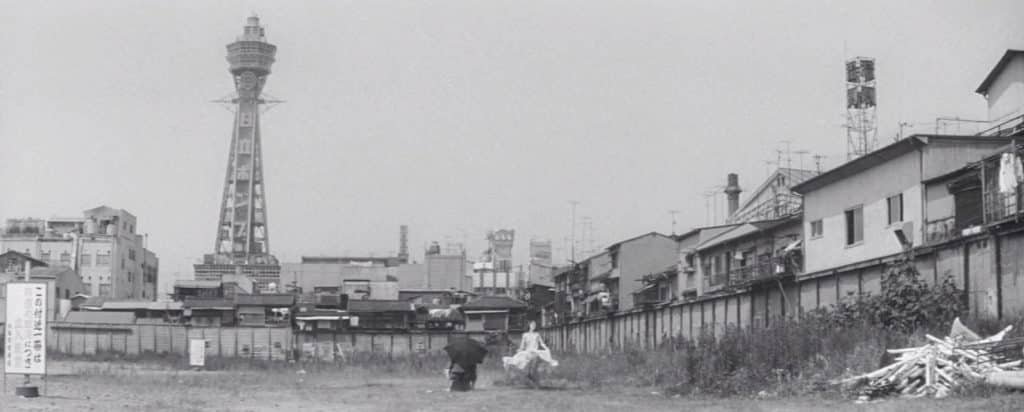
The Director: Noboru Tanaka
Noboru Tanaka (1937 – 2006) took the opposite route. Tanaka began his film work as a production assistant on Akira Kurosawa’s classic Yojimbo in 1961. Kurosawa being the most venerated of the Japanese movie masters.
Tanaka then started working at Nikkatsu, soon becoming an assistant to some of their best directors, including Seijun Suzuki and Shohei Imamura. His work with Imamura included the production of the Osaka-shot The Pornographers (1966), a movie partly dealing with the sex trade.
Once Nikkatsu switched to Roman Porno, Tanaka became one of their most treasured directors. His film A Woman Called Sada Abe (1975) told the same true story a year later internationally immortalized by Nagisa Oshima in In the Realm of the Senses. His most successful film was however Walker in the Attic (1976), based on a mystery story by Edogawa Rampo, Japan’s most famous crime mystery writer.
Tanaka spent all of his directing career as a pink movie maker. For many years with Nikkatsu but from the early 1980s on working for other studios. He retired in 1988, the same year when Nikkatsu shut down their Roman Porno business.
Osaka Locations
Noboru Tanka was clearly in awe with Tsutenkaku Tower for the duration of Secret Chronicle. The tower shows up again, again and again during the movie.
At the end, Tome’s brother Taneo climbs up all the stairs to the top, offering views onto the immediate surroundings below the tower including the Shin Sekai Gekijo Theater. The name of the theater is spelled out on its roof in big kanji characters, perhaps in an attempt to lure visitors of the tower to check out a show.
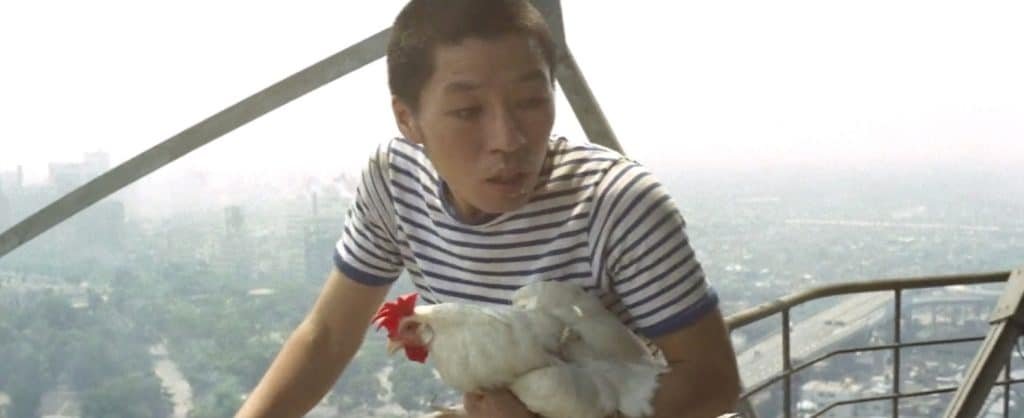
Tanaka also documents the rough streets of Kamagaski. In fact, at the time of filming, the name of the neighborhood had already officially been changed to Airin.
In the 1960s, Kamagasaki repeatedly made the news for riots by the resident homeless. Thus, the city bureaucrats changed the name of the area. The old name still lives on, however.
In 1970, the Airin Labor Welfare Center was opened in the former Kamagasaki, a huge complex meant to provide support to the homeless.
Within a few years, the Airin Labor Welfare Center became an absolutely ghastly house of horrors with mentally ill homeless camping out on flattened cardboard boxes all over the huge hallways. It was torn down in about 2020.
At the time of Tanaka’s filming, however, the Airin Labor Welfare Center was still new and somewhat presentable. Filming inside was still permitted.
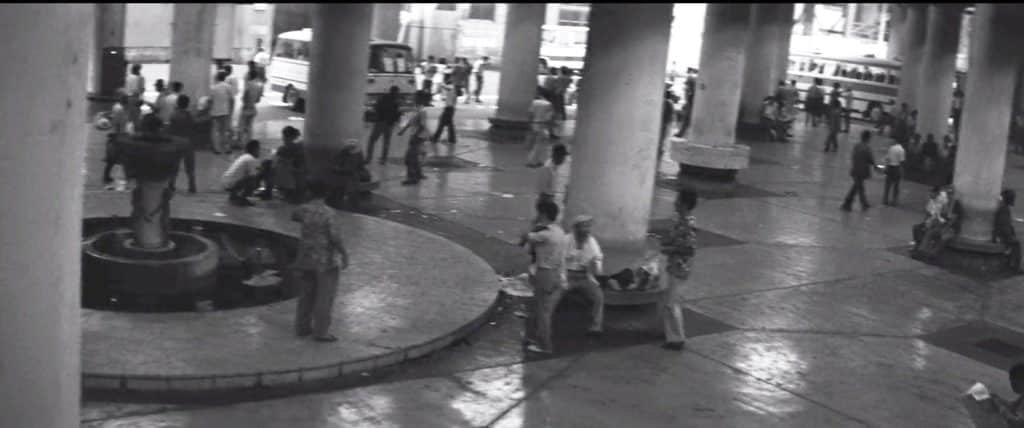
During most of its duration, the film stays within viewing distance of Tsutenkaku Tower.
Straying off a bit further, Tennoji train station makes a few appearances.
Only when the brief color section sets in towards the end, the film truly ventures out of the area.
Suddenly, we are presented with images of beautiful Osaka river sides, of Osaka Castle, of Dotonbori, of Shitennoji Temple with its 5-story pagoda, of historic Taikobashi Bridge at Sumiyoshi Taisha Shrine.
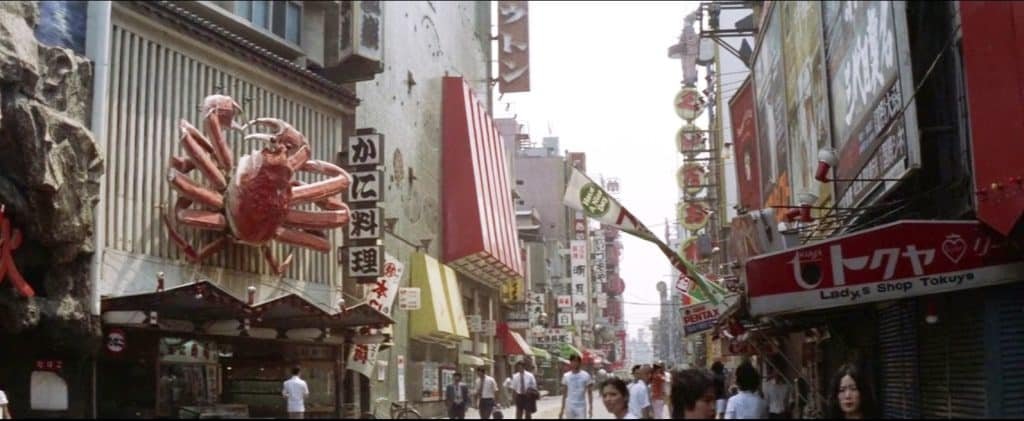
Don’t be afraid of Osaka, those images seem to say. The city has much more to offer than the grim streets of Kamagasaki.
























